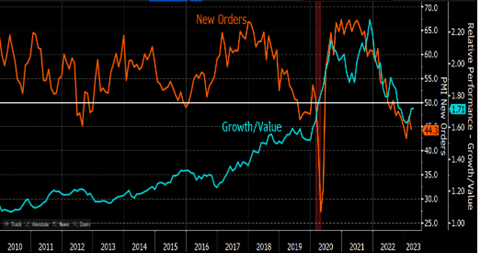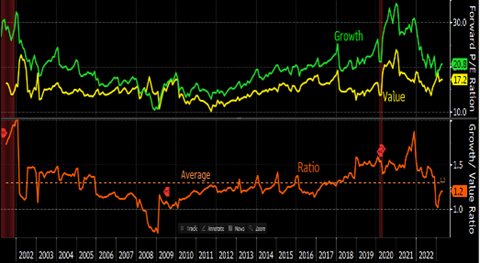In charts: why the ‘stars are aligning’ for growth shares
14th June 2023 10:18
by Sam Benstead from interactive investor
The strong start to the year for expensive shares looks set to continue, writes Sam Benstead.

Fast-growing but expensive shares have made a comeback this year, taking back the lead over cheap “value” shares over the past 12 months and nearly catching them over three years.
Expectations that interest rates are close to peaking, particularly in America where the largest technology companies are listed, have sparked a revival in growth shares.
- Invest with ii: Top ISA Funds | FTSE Tracker Funds | Open a Stocks & Shares ISA
In 2022, growth shares struggled as the return on safe government bonds increased, which therefore decreased the appeal of owning shares whose profits were expected a long way into the future.
In contrast, cheaper shares were boosted by rising commodity prices, with mining and oil key parts of a value investor’s hunting ground. Cheap shares also make a lot of money today and generally have large dividend yields, making future earnings less of a factor in their investment case.
Excitement around the potential of artificial intelligence is also driving up the prices of fast-growth technology stocks, who are set to be the leaders in this technological breakthrough.
- From Nick Train to property, the out-of-form funds pros are buying
- The two areas where professional investors are finding value
- Artificial intelligence: is the hype real, and how to invest in the winners
- The funds and trusts profiting from Nvidia’s unstoppable rise
Over 12 months, the MSCI All Country World Growth index is up 15% and the MSCI All Country World Value index is up just 2%. Over three years the returns are 34% and 37.5%. Over 10 years the growth index has doubled the return of the value index, delivering 243% total returns versus 121% for value.
Gerrit Smit, manager of the Stonehage Fleming Global Best Ideas Equity, says there are three key data points that support the recovery of growth shares – and point to a continuation of the trend.
Smit says that the conditions under which value can continue to outperform have “simply run their course” and the “stars are aligning” for growth shares.
Falling US bond yields
Smit points to falling US government bond yields as an indication that investors do not expect interest rates to go any higher.
He said “While core US inflation remains somewhat sticky, US headline inflation has been dropping and the Federal Reserve’s task of controlling rates through hiking rates seems to be mostly done. US interest rates are settling at lower levels than feared just a few months ago.”
The chart below shows how the yield on the Treasury bond has fallen recently.
- Bond Watch: why it could be time to buy investment grade bonds
- Bonds vs equities: where should income-seekers turn?
Smit adds that it is unlikely that economic growth will rebound, which is something that is good for value shares, which tend to be in cyclical business areas, such as the mining sector.
One measure of this is the copper/gold ratio, which he says is broadly a proxy for economic growth and has been falling recently.
“This indicates that the economy is not going to bail investors out. It therefore argues for growth shares at the expense of value shares.”
The chart below shows how the copper/bond ratio has been falling in the past few months, which has been accompanied by a fall in value shares relative to growth shares.

Source: Stonehage Fleming. Past performance is not a guide to future performance.
Manufacturing uptick
Another reason for a sunny outlook for growth shares, according to Smit, is that the business activity, as measured by the Manufacturing New Orders Index, is showing signs of growth.
“With supply chain complications following the pandemic now mostly resolved, the Orders Index is unlikely to stay in contraction territory for long. On this basis, investors may be considering switching to growth shares.”
- Fund sales are booming – these sectors are attracting the most cash
- The index funds and ETFs that active funds struggle to beat
Smit’s research shows that growth shares tend to do better when economic activity picks up. The chart below shows how growth shares underperformed value shares when the New Orders index was falling, but that the pattern could now be about to change if manufacturing picks up.

Source: Stonehage Fleming. Past performance is not a guide to future performance.
Valuations are tempting
While growth shares are by definition more expensive than value shares, as measured by share prices relative to earnings, Smit says that growth shares are relatively cheap versus historic levels.
“The relative valuation ratio is currently below its long-term average. Especially with a fairly dull economic and earnings growth outlook, this relative valuation level is now more attractive than it has been since 2017.”
- Why I sold Fundsmith to buy a passive tracker
- Day in the life of a fund manager: Vanguard’s Mohneet Dhir
The chart below shows that growth shares in America’s S&P 500 index trade at a price-to-earnings (p/e) ratio of 20.8 compared with 17.2 for value shares. Growth’s p/e dropped from more than 30 times towards the end of 2021, while value’s has been increasing over the past year.
The orange line on the chart below shows that the p/e ratio of growth relative to value shares is below the long-run average, suggesting it is not too late to buy growth stocks.

Source: Stonehage Fleming. Past performance is not a guide to future performance.
These articles are provided for information purposes only. Occasionally, an opinion about whether to buy or sell a specific investment may be provided by third parties. The content is not intended to be a personal recommendation to buy or sell any financial instrument or product, or to adopt any investment strategy as it is not provided based on an assessment of your investing knowledge and experience, your financial situation or your investment objectives. The value of your investments, and the income derived from them, may go down as well as up. You may not get back all the money that you invest. The investments referred to in this article may not be suitable for all investors, and if in doubt, an investor should seek advice from a qualified investment adviser.
Full performance can be found on the company or index summary page on the interactive investor website. Simply click on the company's or index name highlighted in the article.